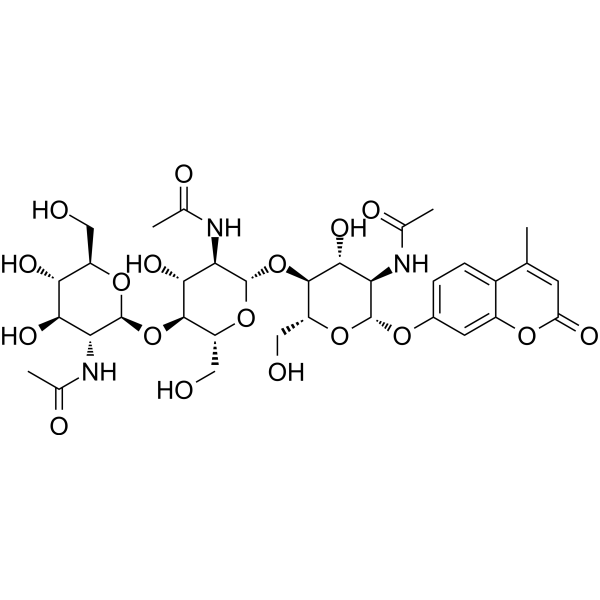4-methylumbelliferyl-n,n',n''-triacetyl-beta-chitotrioside

4-methylumbelliferyl-n,n',n''-triacetyl-beta-chitotrioside structure
|
Common Name | 4-methylumbelliferyl-n,n',n''-triacetyl-beta-chitotrioside | ||
|---|---|---|---|---|
| CAS Number | 53643-13-3 | Molecular Weight | 785.75 | |
| Density | N/A | Boiling Point | N/A | |
| Molecular Formula | C34H47N3O18 | Melting Point | 256-257ºC dec. | |
| MSDS | USA | Flash Point | N/A | |
|
Kinetic analysis of barley chitinase.
Arch. Biochem. Biophys. 344 , 335-342, (1997) The endochitinase from barley is the archetypal enzyme for a large class of plant-derived antifungal chitinases. The X-ray structure was solved previously in our laboratory and a mechanism of action proposed based on structural considerations. In this manuscr... |
|
|
Hydrolysis of 4-methylumbelliferyl N-acetyl-chitotrioside catalyzed by hen and turkey lysozymes. pH dependence of the kinetics constants.
J. Biochem. 87 , 1003-1014, (1980) The binding constants of 4-methylumbelliferyl-beta-glycosides of (GlcNAc)2 ((GlcNAc)2-MeU) and of (GlcNAc)3 ((GlcNAc)3-MeU) to hen lysozyme [EC 3.2.1.17] were determined by measuring changes in the fluorescence at 375 nm. It was shown that (GlcNAc)2-MeU and (... |
|
|
Genomic analysis and initial characterization of the chitinolytic system of Microbulbifer degradans strain 2-40.
J. Bacteriol. 185 , 3352-3360, (2003) The marine bacterium Microbulbifer degradans strain 2-40 produces at least 10 enzyme systems for degrading insoluble complex polysaccharides (ICP). The draft sequence of the 2-40 genome allowed a genome-wide analysis of the chitinolytic system of strain 2-40.... |
|
|
Proteins of the Rpf (resuscitation promoting factor) family are peptidoglycan hydrolases.
Biochemistry 71 , 414-422, (2006) The secreted Micrococcus luteus protein, Rpf, is required for successful resuscitation of dormant "non-culturable" M. luteus cells and for growth stimulation in poor media. The biochemical mechanism of Rpf action remained unknown. Theoretical predictions of R... |
|
|
Gaucher iPSC-derived macrophages produce elevated levels of inflammatory mediators and serve as a new platform for therapeutic development. Panicker LM, Miller D, Awad O, et al.
Stem Cells 32(9) , 2338-49, (2014)
|
|
|
Identification of two GH18 chitinase family genes and their use as targets for detection of the crayfish-plague oomycete Aphanomyces astaci.
BMC Microbiol. 9 , 184, (2009) The oomycete Aphanomyces astaci is regarded as the causative agent of crayfish plague and represents an evident hazard for European crayfish species. Native crayfish populations infected with this pathogen suffer up to 100% mortality. The existence of multipl... |